Analysis of International Trade Theories, Barriers, and Agreements
VerifiedAdded on 2023/04/10
|15
|3523
|144
Report
AI Summary
This report provides a comprehensive analysis of international trade, exploring various theories such as mercantilism and comparative advantage, and examining the impact of trade barriers like tariffs and foreign investment controls. It discusses the role of the World Trade Organization (WTO) and evaluates trade agreements, including New Zealand's agreements with China and the Trans-Pacific Partnership. The report also delves into the rationale behind trade agreements, the effects of tariffs on imports and exports, and techniques to promote international trade, highlighting the benefits and potential drawbacks of different trade policies and practices. Desklib offers more resources for students studying international business and trade.

qwertyuiopasdfghjklzxcvbnmqwerty
uiopasdfghjklzxcvbnmqwertyuiopasd
fghjklzxcvbnmqwertyuiopasdfghjklzx
cvbnmqwertyuiopasdfghjklzxcvbnmq
wertyuiopasdfghjklzxcvbnmqwertyui
opasdfghjklzxcvbnmqwertyuiopasdfg
hjklzxcvbnmqwertyuiopasdfghjklzxc
vbnmqwertyuiopasdfghjklzxcvbnmq
wertyuiopasdfghjklzxcvbnmqwertyui
opasdfghjklzxcvbnmqwertyuiopasdfg
hjklzxcvbnmqwertyuiopasdfghjklzxc
vbnmqwertyuiopasdfghjklzxcvbnmq
wertyuiopasdfghjklzxcvbnmqwertyui
opasdfghjklzxcvbnmqwertyuiopasdfg
hjklzxcvbnmrtyuiopasdfghjklzxcvbn
mqwertyuiopasdfghjklzxcvbnmqwert
yuiopasdfghjklzxcvbnmqwertyuiopas
Business environment
1
uiopasdfghjklzxcvbnmqwertyuiopasd
fghjklzxcvbnmqwertyuiopasdfghjklzx
cvbnmqwertyuiopasdfghjklzxcvbnmq
wertyuiopasdfghjklzxcvbnmqwertyui
opasdfghjklzxcvbnmqwertyuiopasdfg
hjklzxcvbnmqwertyuiopasdfghjklzxc
vbnmqwertyuiopasdfghjklzxcvbnmq
wertyuiopasdfghjklzxcvbnmqwertyui
opasdfghjklzxcvbnmqwertyuiopasdfg
hjklzxcvbnmqwertyuiopasdfghjklzxc
vbnmqwertyuiopasdfghjklzxcvbnmq
wertyuiopasdfghjklzxcvbnmqwertyui
opasdfghjklzxcvbnmqwertyuiopasdfg
hjklzxcvbnmrtyuiopasdfghjklzxcvbn
mqwertyuiopasdfghjklzxcvbnmqwert
yuiopasdfghjklzxcvbnmqwertyuiopas
Business environment
1
Secure Best Marks with AI Grader
Need help grading? Try our AI Grader for instant feedback on your assignments.
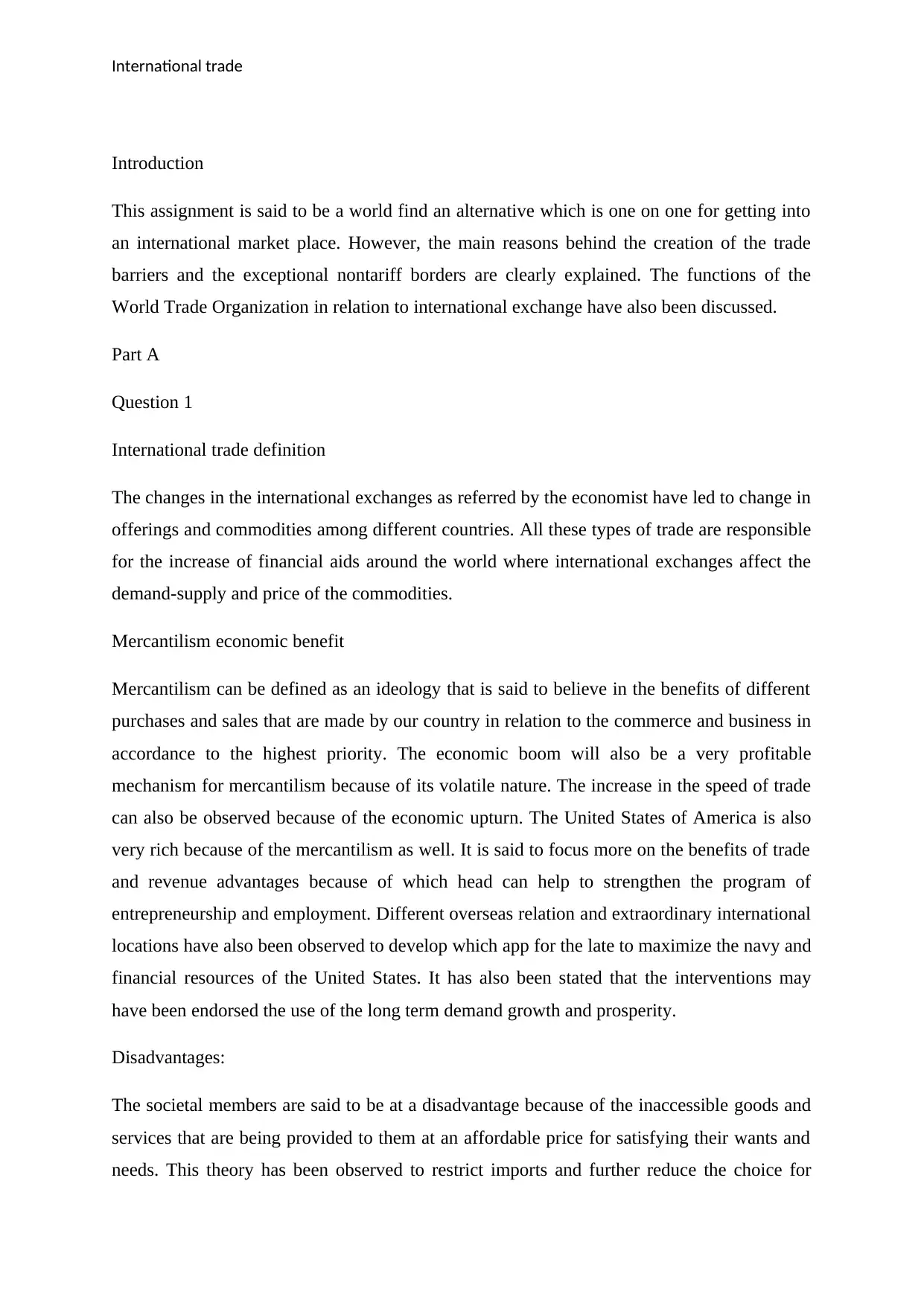
International trade
Introduction
This assignment is said to be a world find an alternative which is one on one for getting into
an international market place. However, the main reasons behind the creation of the trade
barriers and the exceptional nontariff borders are clearly explained. The functions of the
World Trade Organization in relation to international exchange have also been discussed.
Part A
Question 1
International trade definition
The changes in the international exchanges as referred by the economist have led to change in
offerings and commodities among different countries. All these types of trade are responsible
for the increase of financial aids around the world where international exchanges affect the
demand-supply and price of the commodities.
Mercantilism economic benefit
Mercantilism can be defined as an ideology that is said to believe in the benefits of different
purchases and sales that are made by our country in relation to the commerce and business in
accordance to the highest priority. The economic boom will also be a very profitable
mechanism for mercantilism because of its volatile nature. The increase in the speed of trade
can also be observed because of the economic upturn. The United States of America is also
very rich because of the mercantilism as well. It is said to focus more on the benefits of trade
and revenue advantages because of which head can help to strengthen the program of
entrepreneurship and employment. Different overseas relation and extraordinary international
locations have also been observed to develop which app for the late to maximize the navy and
financial resources of the United States. It has also been stated that the interventions may
have been endorsed the use of the long term demand growth and prosperity.
Disadvantages:
The societal members are said to be at a disadvantage because of the inaccessible goods and
services that are being provided to them at an affordable price for satisfying their wants and
needs. This theory has been observed to restrict imports and further reduce the choice for
Introduction
This assignment is said to be a world find an alternative which is one on one for getting into
an international market place. However, the main reasons behind the creation of the trade
barriers and the exceptional nontariff borders are clearly explained. The functions of the
World Trade Organization in relation to international exchange have also been discussed.
Part A
Question 1
International trade definition
The changes in the international exchanges as referred by the economist have led to change in
offerings and commodities among different countries. All these types of trade are responsible
for the increase of financial aids around the world where international exchanges affect the
demand-supply and price of the commodities.
Mercantilism economic benefit
Mercantilism can be defined as an ideology that is said to believe in the benefits of different
purchases and sales that are made by our country in relation to the commerce and business in
accordance to the highest priority. The economic boom will also be a very profitable
mechanism for mercantilism because of its volatile nature. The increase in the speed of trade
can also be observed because of the economic upturn. The United States of America is also
very rich because of the mercantilism as well. It is said to focus more on the benefits of trade
and revenue advantages because of which head can help to strengthen the program of
entrepreneurship and employment. Different overseas relation and extraordinary international
locations have also been observed to develop which app for the late to maximize the navy and
financial resources of the United States. It has also been stated that the interventions may
have been endorsed the use of the long term demand growth and prosperity.
Disadvantages:
The societal members are said to be at a disadvantage because of the inaccessible goods and
services that are being provided to them at an affordable price for satisfying their wants and
needs. This theory has been observed to restrict imports and further reduce the choice for
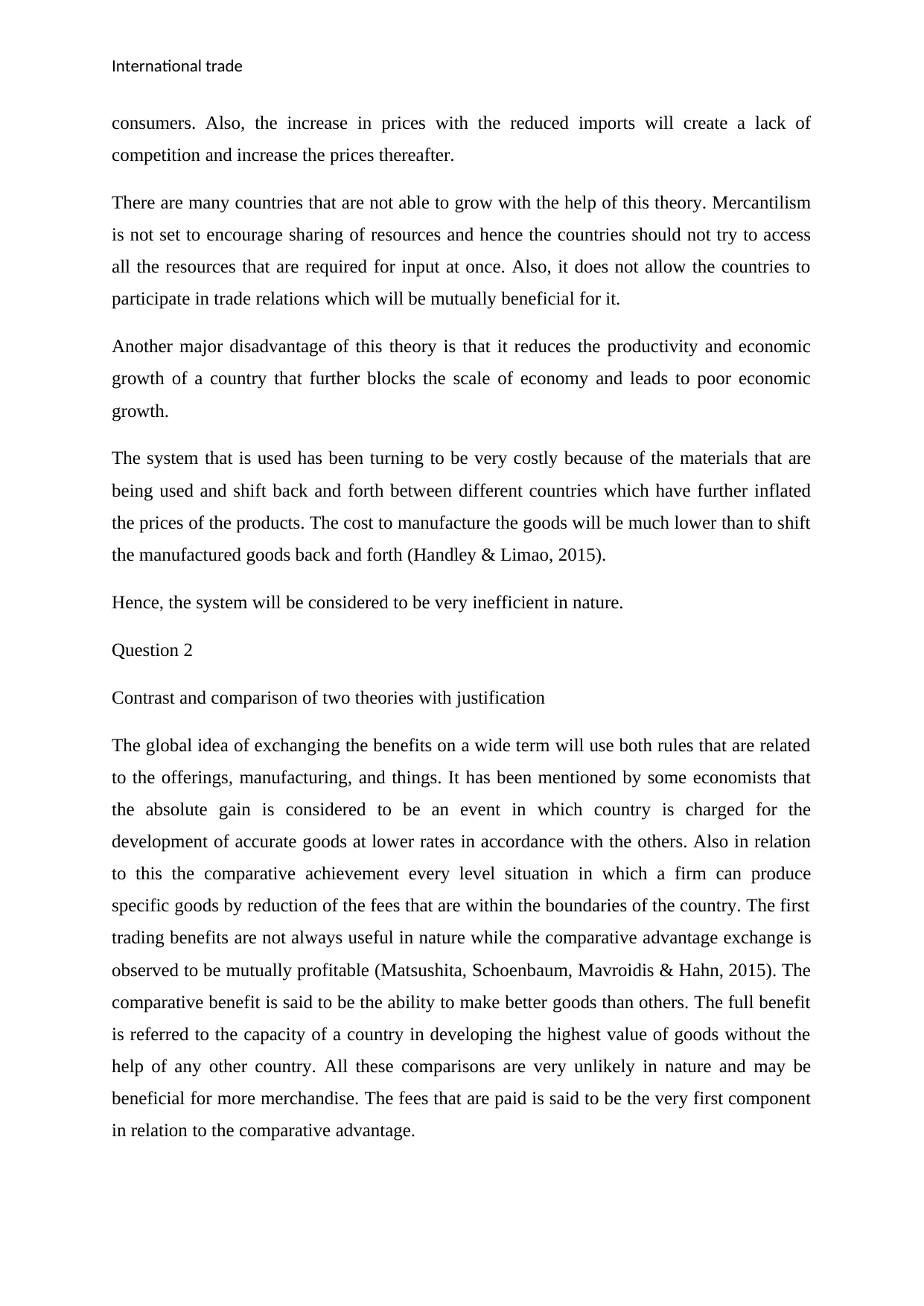
International trade
consumers. Also, the increase in prices with the reduced imports will create a lack of
competition and increase the prices thereafter.
There are many countries that are not able to grow with the help of this theory. Mercantilism
is not set to encourage sharing of resources and hence the countries should not try to access
all the resources that are required for input at once. Also, it does not allow the countries to
participate in trade relations which will be mutually beneficial for it.
Another major disadvantage of this theory is that it reduces the productivity and economic
growth of a country that further blocks the scale of economy and leads to poor economic
growth.
The system that is used has been turning to be very costly because of the materials that are
being used and shift back and forth between different countries which have further inflated
the prices of the products. The cost to manufacture the goods will be much lower than to shift
the manufactured goods back and forth (Handley & Limao, 2015).
Hence, the system will be considered to be very inefficient in nature.
Question 2
Contrast and comparison of two theories with justification
The global idea of exchanging the benefits on a wide term will use both rules that are related
to the offerings, manufacturing, and things. It has been mentioned by some economists that
the absolute gain is considered to be an event in which country is charged for the
development of accurate goods at lower rates in accordance with the others. Also in relation
to this the comparative achievement every level situation in which a firm can produce
specific goods by reduction of the fees that are within the boundaries of the country. The first
trading benefits are not always useful in nature while the comparative advantage exchange is
observed to be mutually profitable (Matsushita, Schoenbaum, Mavroidis & Hahn, 2015). The
comparative benefit is said to be the ability to make better goods than others. The full benefit
is referred to the capacity of a country in developing the highest value of goods without the
help of any other country. All these comparisons are very unlikely in nature and may be
beneficial for more merchandise. The fees that are paid is said to be the very first component
in relation to the comparative advantage.
consumers. Also, the increase in prices with the reduced imports will create a lack of
competition and increase the prices thereafter.
There are many countries that are not able to grow with the help of this theory. Mercantilism
is not set to encourage sharing of resources and hence the countries should not try to access
all the resources that are required for input at once. Also, it does not allow the countries to
participate in trade relations which will be mutually beneficial for it.
Another major disadvantage of this theory is that it reduces the productivity and economic
growth of a country that further blocks the scale of economy and leads to poor economic
growth.
The system that is used has been turning to be very costly because of the materials that are
being used and shift back and forth between different countries which have further inflated
the prices of the products. The cost to manufacture the goods will be much lower than to shift
the manufactured goods back and forth (Handley & Limao, 2015).
Hence, the system will be considered to be very inefficient in nature.
Question 2
Contrast and comparison of two theories with justification
The global idea of exchanging the benefits on a wide term will use both rules that are related
to the offerings, manufacturing, and things. It has been mentioned by some economists that
the absolute gain is considered to be an event in which country is charged for the
development of accurate goods at lower rates in accordance with the others. Also in relation
to this the comparative achievement every level situation in which a firm can produce
specific goods by reduction of the fees that are within the boundaries of the country. The first
trading benefits are not always useful in nature while the comparative advantage exchange is
observed to be mutually profitable (Matsushita, Schoenbaum, Mavroidis & Hahn, 2015). The
comparative benefit is said to be the ability to make better goods than others. The full benefit
is referred to the capacity of a country in developing the highest value of goods without the
help of any other country. All these comparisons are very unlikely in nature and may be
beneficial for more merchandise. The fees that are paid is said to be the very first component
in relation to the comparative advantage.
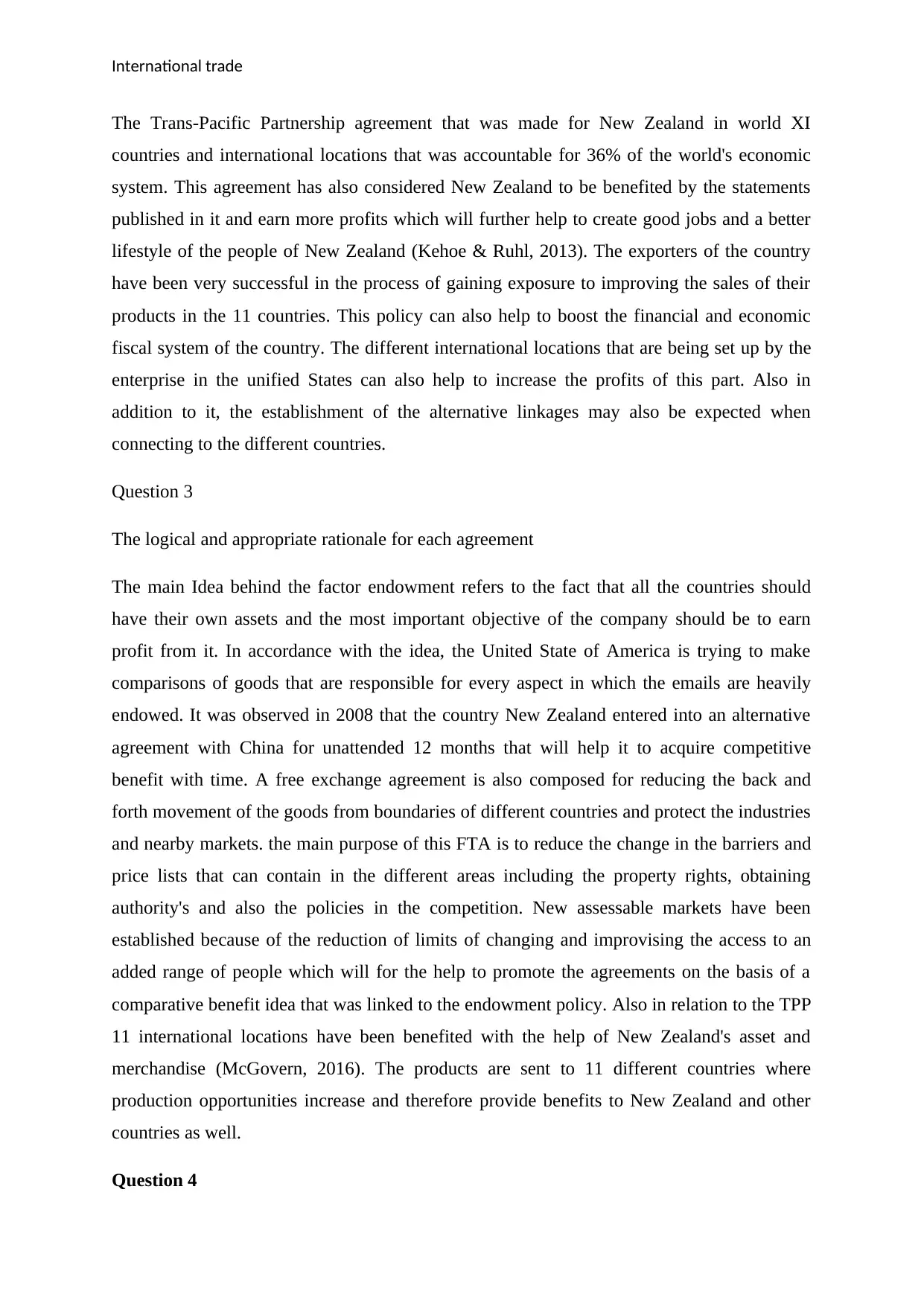
International trade
The Trans-Pacific Partnership agreement that was made for New Zealand in world XI
countries and international locations that was accountable for 36% of the world's economic
system. This agreement has also considered New Zealand to be benefited by the statements
published in it and earn more profits which will further help to create good jobs and a better
lifestyle of the people of New Zealand (Kehoe & Ruhl, 2013). The exporters of the country
have been very successful in the process of gaining exposure to improving the sales of their
products in the 11 countries. This policy can also help to boost the financial and economic
fiscal system of the country. The different international locations that are being set up by the
enterprise in the unified States can also help to increase the profits of this part. Also in
addition to it, the establishment of the alternative linkages may also be expected when
connecting to the different countries.
Question 3
The logical and appropriate rationale for each agreement
The main Idea behind the factor endowment refers to the fact that all the countries should
have their own assets and the most important objective of the company should be to earn
profit from it. In accordance with the idea, the United State of America is trying to make
comparisons of goods that are responsible for every aspect in which the emails are heavily
endowed. It was observed in 2008 that the country New Zealand entered into an alternative
agreement with China for unattended 12 months that will help it to acquire competitive
benefit with time. A free exchange agreement is also composed for reducing the back and
forth movement of the goods from boundaries of different countries and protect the industries
and nearby markets. the main purpose of this FTA is to reduce the change in the barriers and
price lists that can contain in the different areas including the property rights, obtaining
authority's and also the policies in the competition. New assessable markets have been
established because of the reduction of limits of changing and improvising the access to an
added range of people which will for the help to promote the agreements on the basis of a
comparative benefit idea that was linked to the endowment policy. Also in relation to the TPP
11 international locations have been benefited with the help of New Zealand's asset and
merchandise (McGovern, 2016). The products are sent to 11 different countries where
production opportunities increase and therefore provide benefits to New Zealand and other
countries as well.
Question 4
The Trans-Pacific Partnership agreement that was made for New Zealand in world XI
countries and international locations that was accountable for 36% of the world's economic
system. This agreement has also considered New Zealand to be benefited by the statements
published in it and earn more profits which will further help to create good jobs and a better
lifestyle of the people of New Zealand (Kehoe & Ruhl, 2013). The exporters of the country
have been very successful in the process of gaining exposure to improving the sales of their
products in the 11 countries. This policy can also help to boost the financial and economic
fiscal system of the country. The different international locations that are being set up by the
enterprise in the unified States can also help to increase the profits of this part. Also in
addition to it, the establishment of the alternative linkages may also be expected when
connecting to the different countries.
Question 3
The logical and appropriate rationale for each agreement
The main Idea behind the factor endowment refers to the fact that all the countries should
have their own assets and the most important objective of the company should be to earn
profit from it. In accordance with the idea, the United State of America is trying to make
comparisons of goods that are responsible for every aspect in which the emails are heavily
endowed. It was observed in 2008 that the country New Zealand entered into an alternative
agreement with China for unattended 12 months that will help it to acquire competitive
benefit with time. A free exchange agreement is also composed for reducing the back and
forth movement of the goods from boundaries of different countries and protect the industries
and nearby markets. the main purpose of this FTA is to reduce the change in the barriers and
price lists that can contain in the different areas including the property rights, obtaining
authority's and also the policies in the competition. New assessable markets have been
established because of the reduction of limits of changing and improvising the access to an
added range of people which will for the help to promote the agreements on the basis of a
comparative benefit idea that was linked to the endowment policy. Also in relation to the TPP
11 international locations have been benefited with the help of New Zealand's asset and
merchandise (McGovern, 2016). The products are sent to 11 different countries where
production opportunities increase and therefore provide benefits to New Zealand and other
countries as well.
Question 4
Secure Best Marks with AI Grader
Need help grading? Try our AI Grader for instant feedback on your assignments.
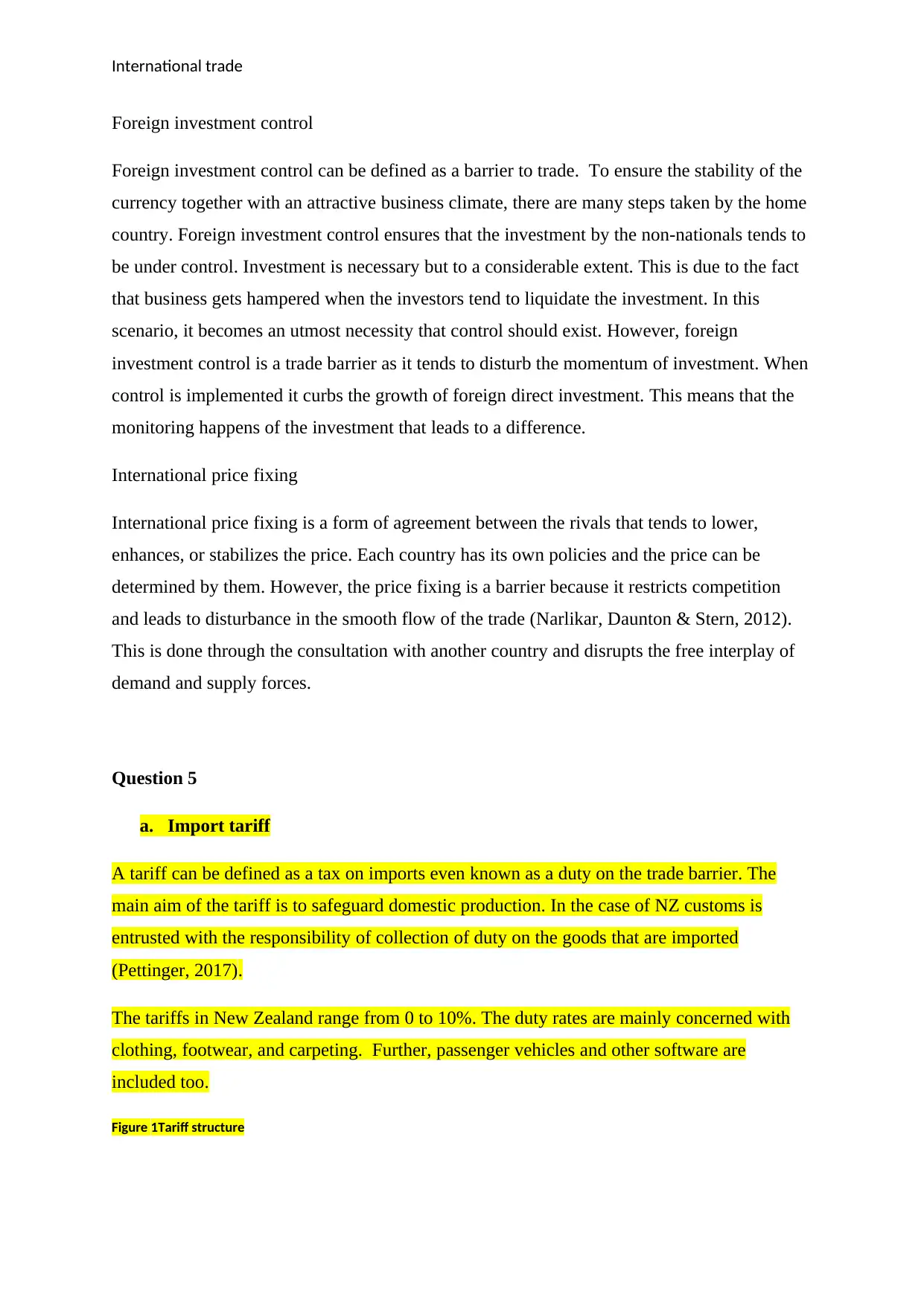
International trade
Foreign investment control
Foreign investment control can be defined as a barrier to trade. To ensure the stability of the
currency together with an attractive business climate, there are many steps taken by the home
country. Foreign investment control ensures that the investment by the non-nationals tends to
be under control. Investment is necessary but to a considerable extent. This is due to the fact
that business gets hampered when the investors tend to liquidate the investment. In this
scenario, it becomes an utmost necessity that control should exist. However, foreign
investment control is a trade barrier as it tends to disturb the momentum of investment. When
control is implemented it curbs the growth of foreign direct investment. This means that the
monitoring happens of the investment that leads to a difference.
International price fixing
International price fixing is a form of agreement between the rivals that tends to lower,
enhances, or stabilizes the price. Each country has its own policies and the price can be
determined by them. However, the price fixing is a barrier because it restricts competition
and leads to disturbance in the smooth flow of the trade (Narlikar, Daunton & Stern, 2012).
This is done through the consultation with another country and disrupts the free interplay of
demand and supply forces.
Question 5
a. Import tariff
A tariff can be defined as a tax on imports even known as a duty on the trade barrier. The
main aim of the tariff is to safeguard domestic production. In the case of NZ customs is
entrusted with the responsibility of collection of duty on the goods that are imported
(Pettinger, 2017).
The tariffs in New Zealand range from 0 to 10%. The duty rates are mainly concerned with
clothing, footwear, and carpeting. Further, passenger vehicles and other software are
included too.
Figure 1Tariff structure
Foreign investment control
Foreign investment control can be defined as a barrier to trade. To ensure the stability of the
currency together with an attractive business climate, there are many steps taken by the home
country. Foreign investment control ensures that the investment by the non-nationals tends to
be under control. Investment is necessary but to a considerable extent. This is due to the fact
that business gets hampered when the investors tend to liquidate the investment. In this
scenario, it becomes an utmost necessity that control should exist. However, foreign
investment control is a trade barrier as it tends to disturb the momentum of investment. When
control is implemented it curbs the growth of foreign direct investment. This means that the
monitoring happens of the investment that leads to a difference.
International price fixing
International price fixing is a form of agreement between the rivals that tends to lower,
enhances, or stabilizes the price. Each country has its own policies and the price can be
determined by them. However, the price fixing is a barrier because it restricts competition
and leads to disturbance in the smooth flow of the trade (Narlikar, Daunton & Stern, 2012).
This is done through the consultation with another country and disrupts the free interplay of
demand and supply forces.
Question 5
a. Import tariff
A tariff can be defined as a tax on imports even known as a duty on the trade barrier. The
main aim of the tariff is to safeguard domestic production. In the case of NZ customs is
entrusted with the responsibility of collection of duty on the goods that are imported
(Pettinger, 2017).
The tariffs in New Zealand range from 0 to 10%. The duty rates are mainly concerned with
clothing, footwear, and carpeting. Further, passenger vehicles and other software are
included too.
Figure 1Tariff structure

International trade
In the case of New Zealand the tariff has been kept on the lower front because when the price
is lower, the domestic consumers will consume Qw goods but as the home country will
produce only Qd thereby it is important that Qw-Qd worth of goods should be imported.
When the tariff or any other price is enhanced then the effect is to enhance the price and
restricts the import volume. Hence, in consideration of this, the rate of the tariff has been kept
low by New Zealand. Over the last decade, the rate has been lower owing to the fact that it
wants the consumer to consumer Qw of goods (WITS, 2019).
b. Export tariff
New Zealand export tariff tend to generate revenue and keep it safe from the competition.
However, over the past decades, the rate of the export tariff has been kept on the lower end
owing to the fact that it wants benefits from the economies of scale. Further, the lower export
duty tends to have gained from free trade (Pettinger, 2017). This also brings the benefit of
lower prices for consumers. Henceforth, it can be seen that NNZ has benefitted from the
concept of economies of scale and tend to lower the prices for consumers.
Figure 2 Tariff Demand and suppply
In the case of New Zealand the tariff has been kept on the lower front because when the price
is lower, the domestic consumers will consume Qw goods but as the home country will
produce only Qd thereby it is important that Qw-Qd worth of goods should be imported.
When the tariff or any other price is enhanced then the effect is to enhance the price and
restricts the import volume. Hence, in consideration of this, the rate of the tariff has been kept
low by New Zealand. Over the last decade, the rate has been lower owing to the fact that it
wants the consumer to consumer Qw of goods (WITS, 2019).
b. Export tariff
New Zealand export tariff tend to generate revenue and keep it safe from the competition.
However, over the past decades, the rate of the export tariff has been kept on the lower end
owing to the fact that it wants benefits from the economies of scale. Further, the lower export
duty tends to have gained from free trade (Pettinger, 2017). This also brings the benefit of
lower prices for consumers. Henceforth, it can be seen that NNZ has benefitted from the
concept of economies of scale and tend to lower the prices for consumers.
Figure 2 Tariff Demand and suppply
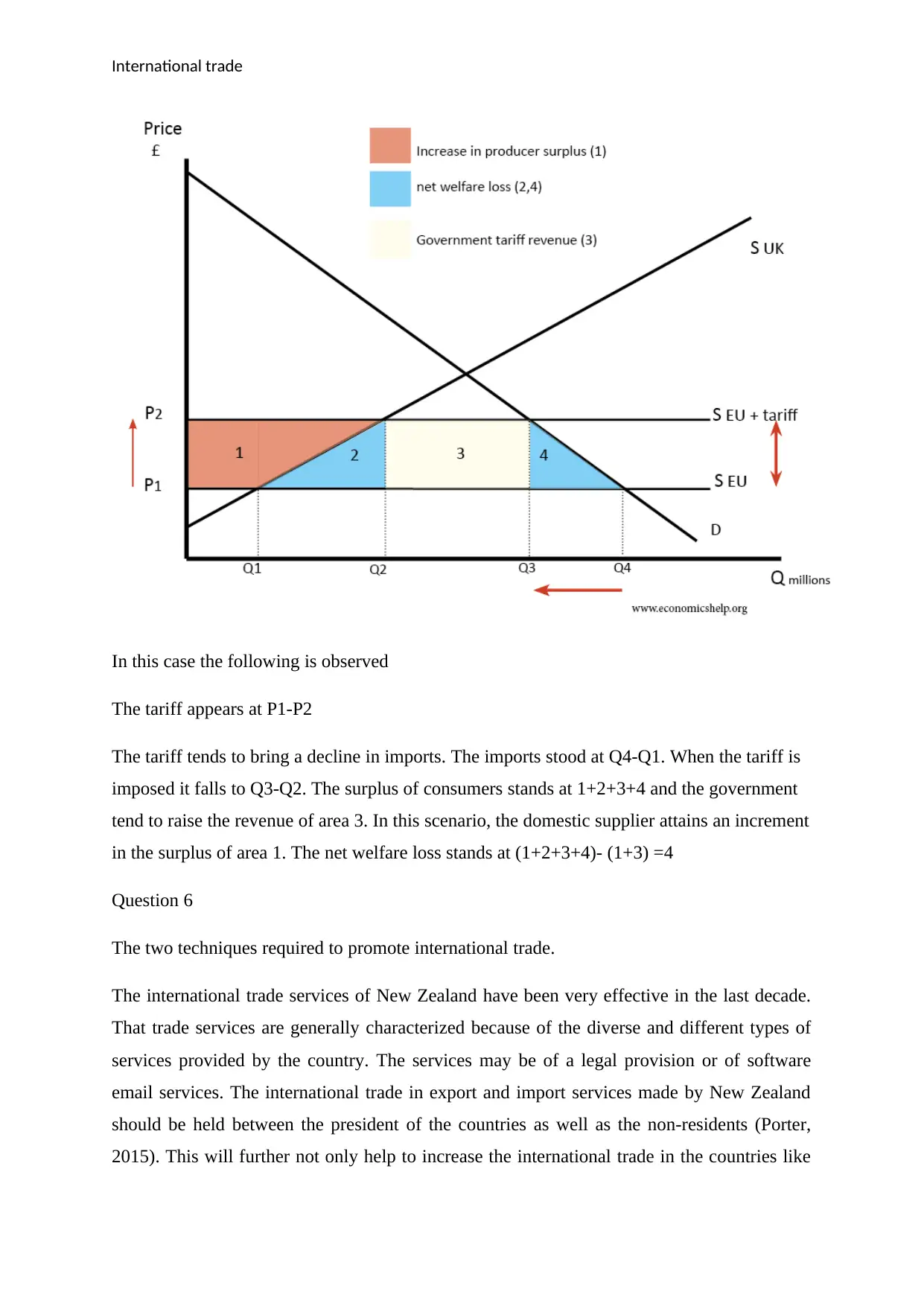
International trade
In this case the following is observed
The tariff appears at P1-P2
The tariff tends to bring a decline in imports. The imports stood at Q4-Q1. When the tariff is
imposed it falls to Q3-Q2. The surplus of consumers stands at 1+2+3+4 and the government
tend to raise the revenue of area 3. In this scenario, the domestic supplier attains an increment
in the surplus of area 1. The net welfare loss stands at (1+2+3+4)- (1+3) =4
Question 6
The two techniques required to promote international trade.
The international trade services of New Zealand have been very effective in the last decade.
That trade services are generally characterized because of the diverse and different types of
services provided by the country. The services may be of a legal provision or of software
email services. The international trade in export and import services made by New Zealand
should be held between the president of the countries as well as the non-residents (Porter,
2015). This will further not only help to increase the international trade in the countries like
In this case the following is observed
The tariff appears at P1-P2
The tariff tends to bring a decline in imports. The imports stood at Q4-Q1. When the tariff is
imposed it falls to Q3-Q2. The surplus of consumers stands at 1+2+3+4 and the government
tend to raise the revenue of area 3. In this scenario, the domestic supplier attains an increment
in the surplus of area 1. The net welfare loss stands at (1+2+3+4)- (1+3) =4
Question 6
The two techniques required to promote international trade.
The international trade services of New Zealand have been very effective in the last decade.
That trade services are generally characterized because of the diverse and different types of
services provided by the country. The services may be of a legal provision or of software
email services. The international trade in export and import services made by New Zealand
should be held between the president of the countries as well as the non-residents (Porter,
2015). This will further not only help to increase the international trade in the countries like
Paraphrase This Document
Need a fresh take? Get an instant paraphrase of this document with our AI Paraphraser
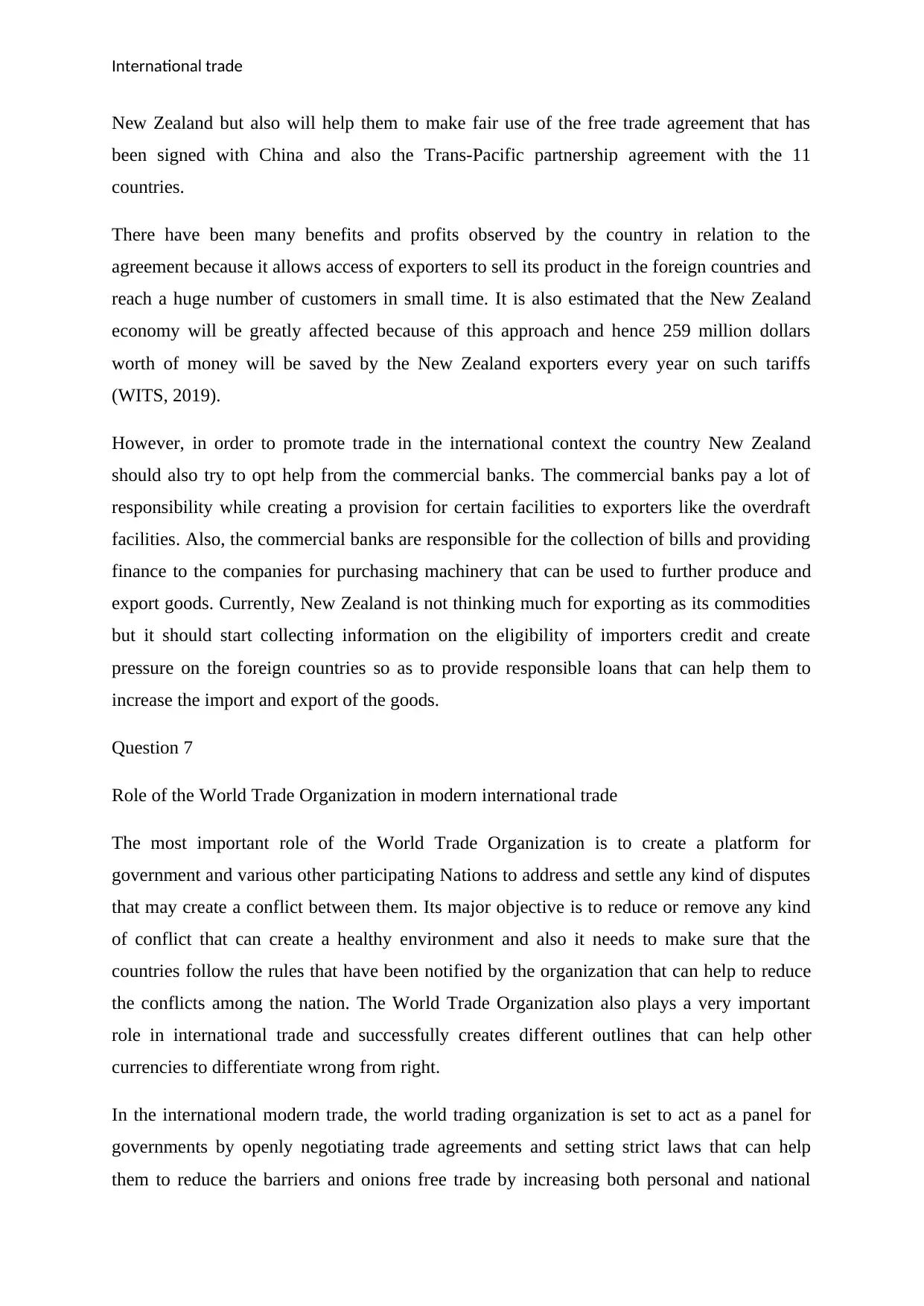
International trade
New Zealand but also will help them to make fair use of the free trade agreement that has
been signed with China and also the Trans-Pacific partnership agreement with the 11
countries.
There have been many benefits and profits observed by the country in relation to the
agreement because it allows access of exporters to sell its product in the foreign countries and
reach a huge number of customers in small time. It is also estimated that the New Zealand
economy will be greatly affected because of this approach and hence 259 million dollars
worth of money will be saved by the New Zealand exporters every year on such tariffs
(WITS, 2019).
However, in order to promote trade in the international context the country New Zealand
should also try to opt help from the commercial banks. The commercial banks pay a lot of
responsibility while creating a provision for certain facilities to exporters like the overdraft
facilities. Also, the commercial banks are responsible for the collection of bills and providing
finance to the companies for purchasing machinery that can be used to further produce and
export goods. Currently, New Zealand is not thinking much for exporting as its commodities
but it should start collecting information on the eligibility of importers credit and create
pressure on the foreign countries so as to provide responsible loans that can help them to
increase the import and export of the goods.
Question 7
Role of the World Trade Organization in modern international trade
The most important role of the World Trade Organization is to create a platform for
government and various other participating Nations to address and settle any kind of disputes
that may create a conflict between them. Its major objective is to reduce or remove any kind
of conflict that can create a healthy environment and also it needs to make sure that the
countries follow the rules that have been notified by the organization that can help to reduce
the conflicts among the nation. The World Trade Organization also plays a very important
role in international trade and successfully creates different outlines that can help other
currencies to differentiate wrong from right.
In the international modern trade, the world trading organization is set to act as a panel for
governments by openly negotiating trade agreements and setting strict laws that can help
them to reduce the barriers and onions free trade by increasing both personal and national
New Zealand but also will help them to make fair use of the free trade agreement that has
been signed with China and also the Trans-Pacific partnership agreement with the 11
countries.
There have been many benefits and profits observed by the country in relation to the
agreement because it allows access of exporters to sell its product in the foreign countries and
reach a huge number of customers in small time. It is also estimated that the New Zealand
economy will be greatly affected because of this approach and hence 259 million dollars
worth of money will be saved by the New Zealand exporters every year on such tariffs
(WITS, 2019).
However, in order to promote trade in the international context the country New Zealand
should also try to opt help from the commercial banks. The commercial banks pay a lot of
responsibility while creating a provision for certain facilities to exporters like the overdraft
facilities. Also, the commercial banks are responsible for the collection of bills and providing
finance to the companies for purchasing machinery that can be used to further produce and
export goods. Currently, New Zealand is not thinking much for exporting as its commodities
but it should start collecting information on the eligibility of importers credit and create
pressure on the foreign countries so as to provide responsible loans that can help them to
increase the import and export of the goods.
Question 7
Role of the World Trade Organization in modern international trade
The most important role of the World Trade Organization is to create a platform for
government and various other participating Nations to address and settle any kind of disputes
that may create a conflict between them. Its major objective is to reduce or remove any kind
of conflict that can create a healthy environment and also it needs to make sure that the
countries follow the rules that have been notified by the organization that can help to reduce
the conflicts among the nation. The World Trade Organization also plays a very important
role in international trade and successfully creates different outlines that can help other
currencies to differentiate wrong from right.
In the international modern trade, the world trading organization is set to act as a panel for
governments by openly negotiating trade agreements and setting strict laws that can help
them to reduce the barriers and onions free trade by increasing both personal and national
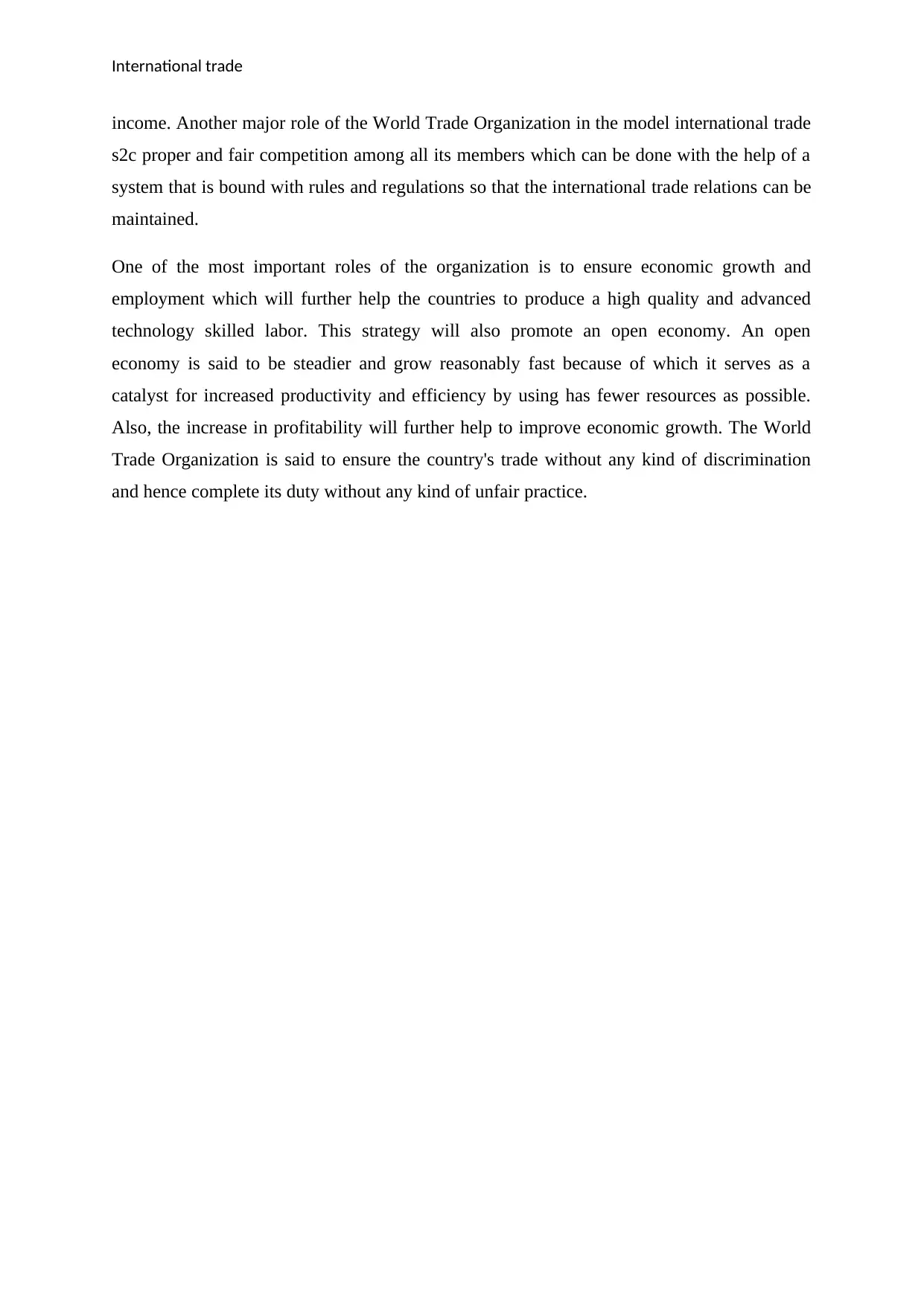
International trade
income. Another major role of the World Trade Organization in the model international trade
s2c proper and fair competition among all its members which can be done with the help of a
system that is bound with rules and regulations so that the international trade relations can be
maintained.
One of the most important roles of the organization is to ensure economic growth and
employment which will further help the countries to produce a high quality and advanced
technology skilled labor. This strategy will also promote an open economy. An open
economy is said to be steadier and grow reasonably fast because of which it serves as a
catalyst for increased productivity and efficiency by using has fewer resources as possible.
Also, the increase in profitability will further help to improve economic growth. The World
Trade Organization is said to ensure the country's trade without any kind of discrimination
and hence complete its duty without any kind of unfair practice.
income. Another major role of the World Trade Organization in the model international trade
s2c proper and fair competition among all its members which can be done with the help of a
system that is bound with rules and regulations so that the international trade relations can be
maintained.
One of the most important roles of the organization is to ensure economic growth and
employment which will further help the countries to produce a high quality and advanced
technology skilled labor. This strategy will also promote an open economy. An open
economy is said to be steadier and grow reasonably fast because of which it serves as a
catalyst for increased productivity and efficiency by using has fewer resources as possible.
Also, the increase in profitability will further help to improve economic growth. The World
Trade Organization is said to ensure the country's trade without any kind of discrimination
and hence complete its duty without any kind of unfair practice.
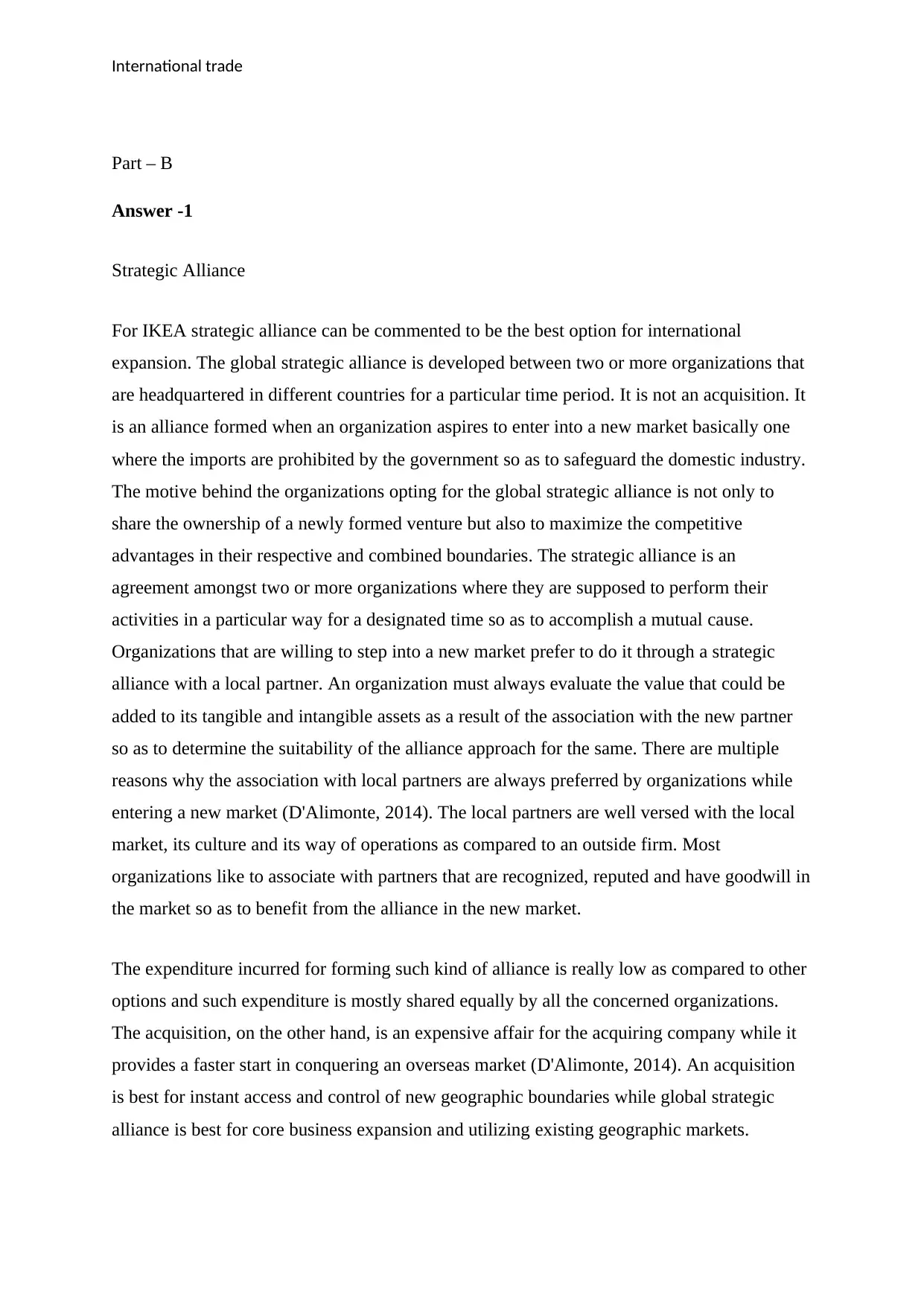
International trade
Part – B
Answer -1
Strategic Alliance
For IKEA strategic alliance can be commented to be the best option for international
expansion. The global strategic alliance is developed between two or more organizations that
are headquartered in different countries for a particular time period. It is not an acquisition. It
is an alliance formed when an organization aspires to enter into a new market basically one
where the imports are prohibited by the government so as to safeguard the domestic industry.
The motive behind the organizations opting for the global strategic alliance is not only to
share the ownership of a newly formed venture but also to maximize the competitive
advantages in their respective and combined boundaries. The strategic alliance is an
agreement amongst two or more organizations where they are supposed to perform their
activities in a particular way for a designated time so as to accomplish a mutual cause.
Organizations that are willing to step into a new market prefer to do it through a strategic
alliance with a local partner. An organization must always evaluate the value that could be
added to its tangible and intangible assets as a result of the association with the new partner
so as to determine the suitability of the alliance approach for the same. There are multiple
reasons why the association with local partners are always preferred by organizations while
entering a new market (D'Alimonte, 2014). The local partners are well versed with the local
market, its culture and its way of operations as compared to an outside firm. Most
organizations like to associate with partners that are recognized, reputed and have goodwill in
the market so as to benefit from the alliance in the new market.
The expenditure incurred for forming such kind of alliance is really low as compared to other
options and such expenditure is mostly shared equally by all the concerned organizations.
The acquisition, on the other hand, is an expensive affair for the acquiring company while it
provides a faster start in conquering an overseas market (D'Alimonte, 2014). An acquisition
is best for instant access and control of new geographic boundaries while global strategic
alliance is best for core business expansion and utilizing existing geographic markets.
Part – B
Answer -1
Strategic Alliance
For IKEA strategic alliance can be commented to be the best option for international
expansion. The global strategic alliance is developed between two or more organizations that
are headquartered in different countries for a particular time period. It is not an acquisition. It
is an alliance formed when an organization aspires to enter into a new market basically one
where the imports are prohibited by the government so as to safeguard the domestic industry.
The motive behind the organizations opting for the global strategic alliance is not only to
share the ownership of a newly formed venture but also to maximize the competitive
advantages in their respective and combined boundaries. The strategic alliance is an
agreement amongst two or more organizations where they are supposed to perform their
activities in a particular way for a designated time so as to accomplish a mutual cause.
Organizations that are willing to step into a new market prefer to do it through a strategic
alliance with a local partner. An organization must always evaluate the value that could be
added to its tangible and intangible assets as a result of the association with the new partner
so as to determine the suitability of the alliance approach for the same. There are multiple
reasons why the association with local partners are always preferred by organizations while
entering a new market (D'Alimonte, 2014). The local partners are well versed with the local
market, its culture and its way of operations as compared to an outside firm. Most
organizations like to associate with partners that are recognized, reputed and have goodwill in
the market so as to benefit from the alliance in the new market.
The expenditure incurred for forming such kind of alliance is really low as compared to other
options and such expenditure is mostly shared equally by all the concerned organizations.
The acquisition, on the other hand, is an expensive affair for the acquiring company while it
provides a faster start in conquering an overseas market (D'Alimonte, 2014). An acquisition
is best for instant access and control of new geographic boundaries while global strategic
alliance is best for core business expansion and utilizing existing geographic markets.
Secure Best Marks with AI Grader
Need help grading? Try our AI Grader for instant feedback on your assignments.
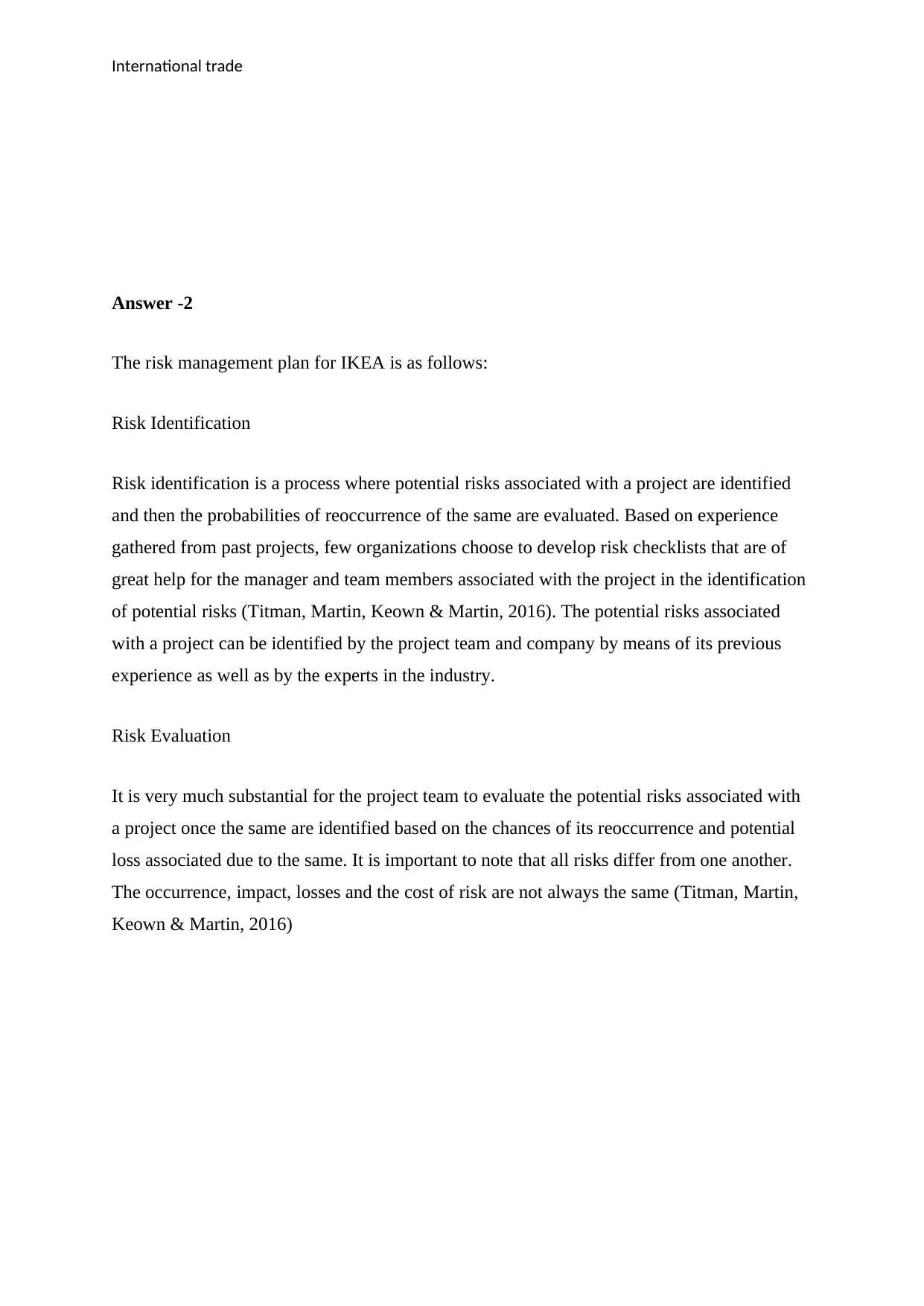
International trade
Answer -2
The risk management plan for IKEA is as follows:
Risk Identification
Risk identification is a process where potential risks associated with a project are identified
and then the probabilities of reoccurrence of the same are evaluated. Based on experience
gathered from past projects, few organizations choose to develop risk checklists that are of
great help for the manager and team members associated with the project in the identification
of potential risks (Titman, Martin, Keown & Martin, 2016). The potential risks associated
with a project can be identified by the project team and company by means of its previous
experience as well as by the experts in the industry.
Risk Evaluation
It is very much substantial for the project team to evaluate the potential risks associated with
a project once the same are identified based on the chances of its reoccurrence and potential
loss associated due to the same. It is important to note that all risks differ from one another.
The occurrence, impact, losses and the cost of risk are not always the same (Titman, Martin,
Keown & Martin, 2016)
Answer -2
The risk management plan for IKEA is as follows:
Risk Identification
Risk identification is a process where potential risks associated with a project are identified
and then the probabilities of reoccurrence of the same are evaluated. Based on experience
gathered from past projects, few organizations choose to develop risk checklists that are of
great help for the manager and team members associated with the project in the identification
of potential risks (Titman, Martin, Keown & Martin, 2016). The potential risks associated
with a project can be identified by the project team and company by means of its previous
experience as well as by the experts in the industry.
Risk Evaluation
It is very much substantial for the project team to evaluate the potential risks associated with
a project once the same are identified based on the chances of its reoccurrence and potential
loss associated due to the same. It is important to note that all risks differ from one another.
The occurrence, impact, losses and the cost of risk are not always the same (Titman, Martin,
Keown & Martin, 2016)
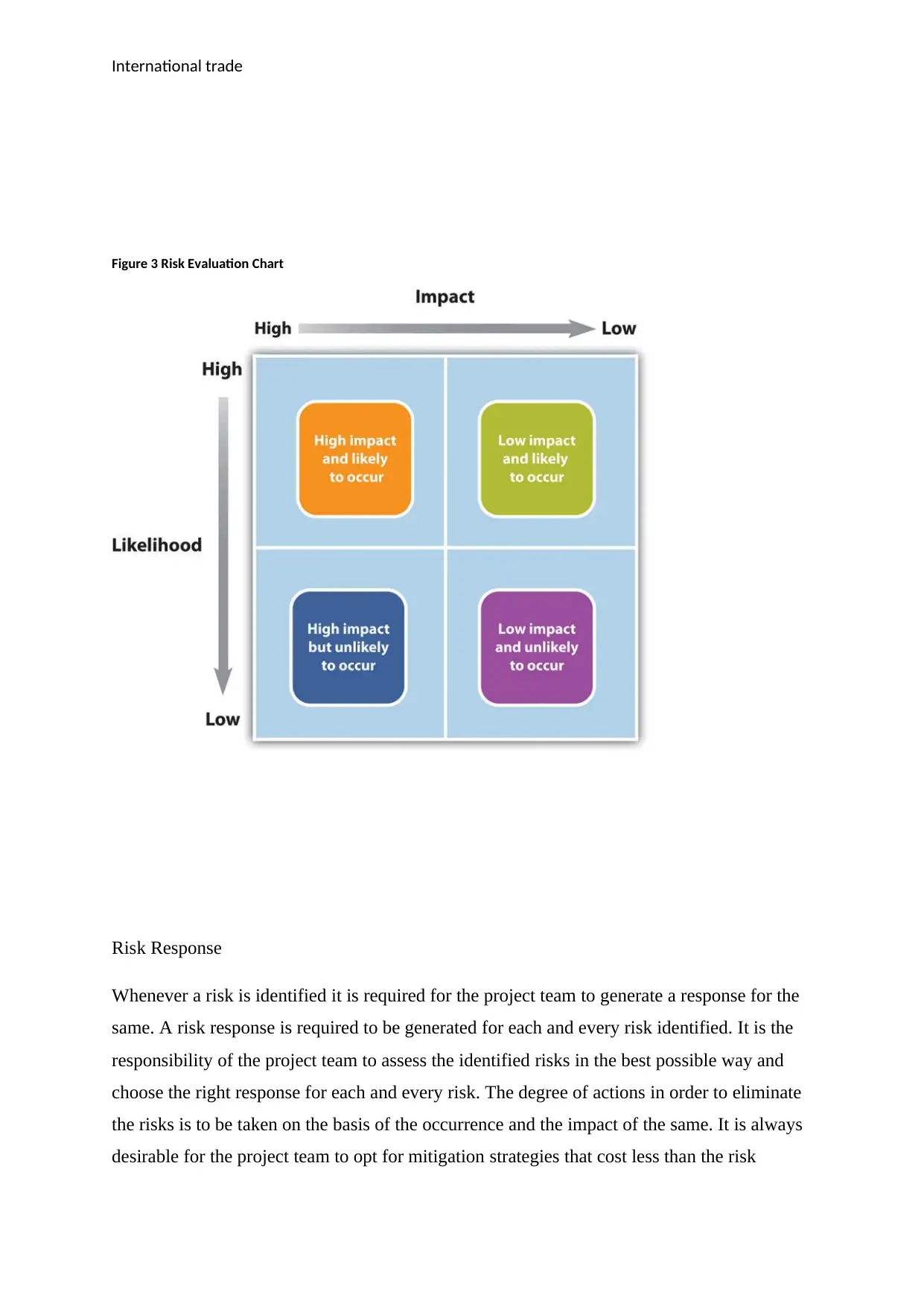
International trade
Figure 3 Risk Evaluation Chart
Risk Response
Whenever a risk is identified it is required for the project team to generate a response for the
same. A risk response is required to be generated for each and every risk identified. It is the
responsibility of the project team to assess the identified risks in the best possible way and
choose the right response for each and every risk. The degree of actions in order to eliminate
the risks is to be taken on the basis of the occurrence and the impact of the same. It is always
desirable for the project team to opt for mitigation strategies that cost less than the risk
Figure 3 Risk Evaluation Chart
Risk Response
Whenever a risk is identified it is required for the project team to generate a response for the
same. A risk response is required to be generated for each and every risk identified. It is the
responsibility of the project team to assess the identified risks in the best possible way and
choose the right response for each and every risk. The degree of actions in order to eliminate
the risks is to be taken on the basis of the occurrence and the impact of the same. It is always
desirable for the project team to opt for mitigation strategies that cost less than the risk
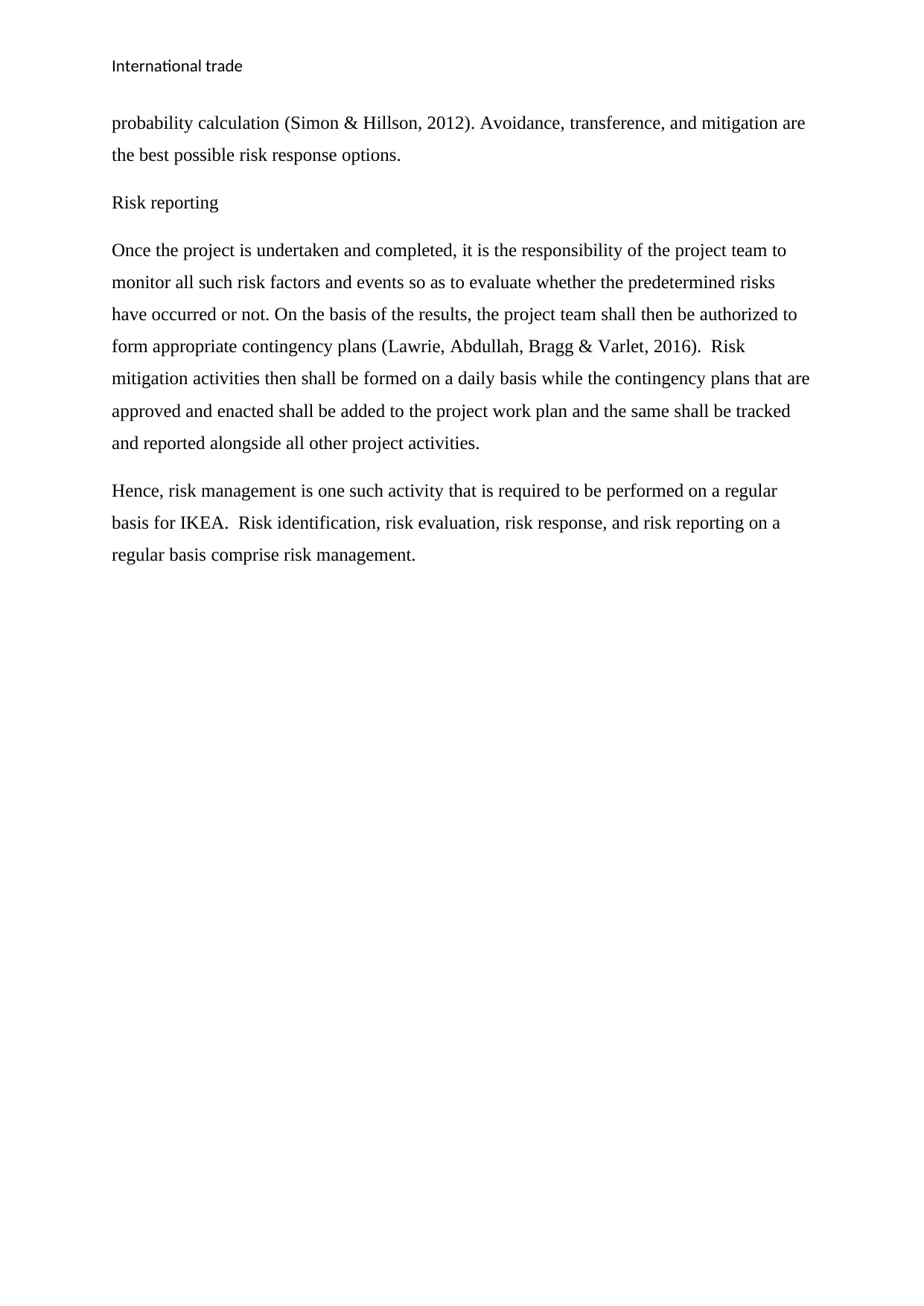
International trade
probability calculation (Simon & Hillson, 2012). Avoidance, transference, and mitigation are
the best possible risk response options.
Risk reporting
Once the project is undertaken and completed, it is the responsibility of the project team to
monitor all such risk factors and events so as to evaluate whether the predetermined risks
have occurred or not. On the basis of the results, the project team shall then be authorized to
form appropriate contingency plans (Lawrie, Abdullah, Bragg & Varlet, 2016). Risk
mitigation activities then shall be formed on a daily basis while the contingency plans that are
approved and enacted shall be added to the project work plan and the same shall be tracked
and reported alongside all other project activities.
Hence, risk management is one such activity that is required to be performed on a regular
basis for IKEA. Risk identification, risk evaluation, risk response, and risk reporting on a
regular basis comprise risk management.
probability calculation (Simon & Hillson, 2012). Avoidance, transference, and mitigation are
the best possible risk response options.
Risk reporting
Once the project is undertaken and completed, it is the responsibility of the project team to
monitor all such risk factors and events so as to evaluate whether the predetermined risks
have occurred or not. On the basis of the results, the project team shall then be authorized to
form appropriate contingency plans (Lawrie, Abdullah, Bragg & Varlet, 2016). Risk
mitigation activities then shall be formed on a daily basis while the contingency plans that are
approved and enacted shall be added to the project work plan and the same shall be tracked
and reported alongside all other project activities.
Hence, risk management is one such activity that is required to be performed on a regular
basis for IKEA. Risk identification, risk evaluation, risk response, and risk reporting on a
regular basis comprise risk management.
Paraphrase This Document
Need a fresh take? Get an instant paraphrase of this document with our AI Paraphraser
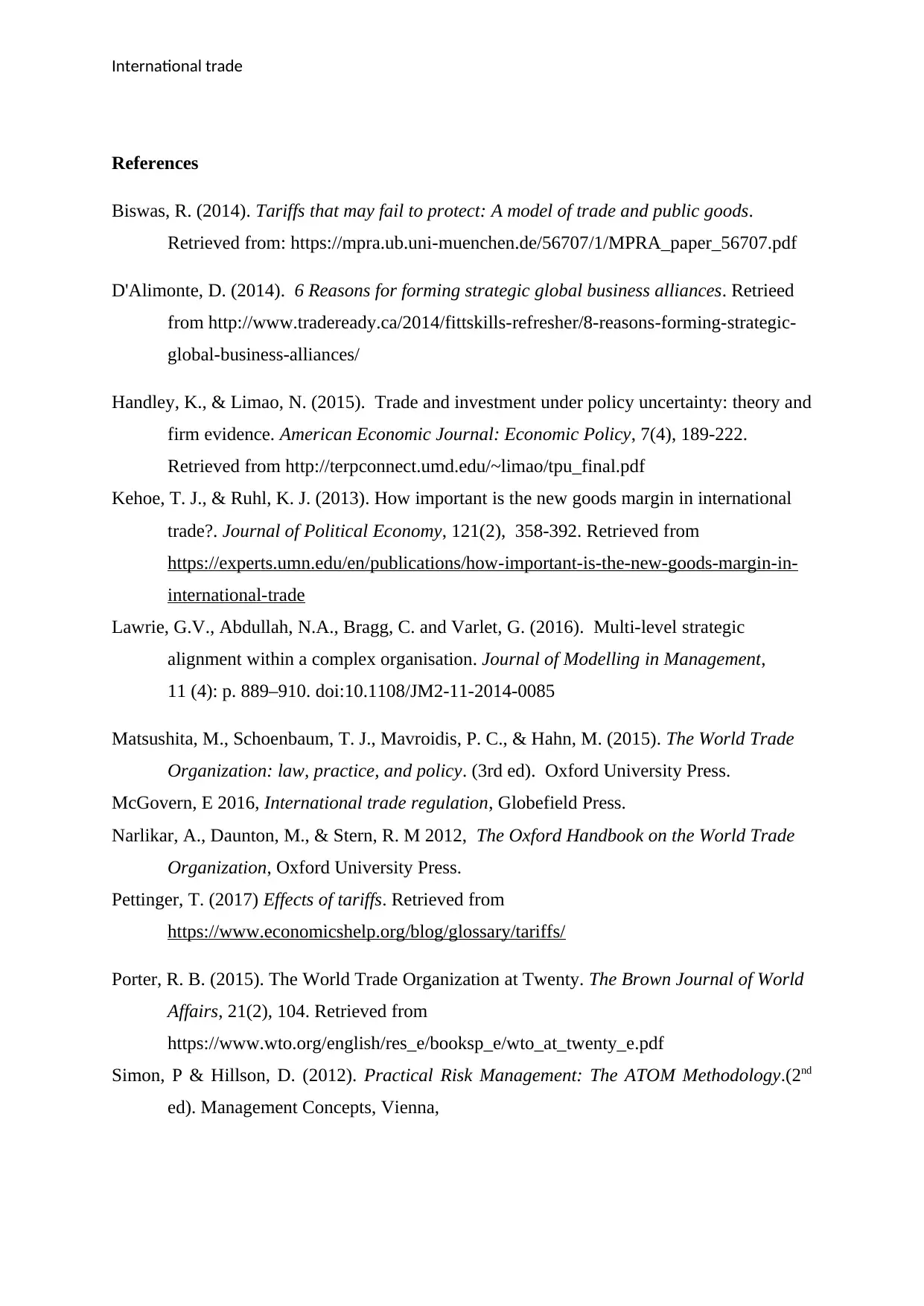
International trade
References
Biswas, R. (2014). Tariffs that may fail to protect: A model of trade and public goods.
Retrieved from: https://mpra.ub.uni-muenchen.de/56707/1/MPRA_paper_56707.pdf
D'Alimonte, D. (2014). 6 Reasons for forming strategic global business alliances. Retrieed
from http://www.tradeready.ca/2014/fittskills-refresher/8-reasons-forming-strategic-
global-business-alliances/
Handley, K., & Limao, N. (2015). Trade and investment under policy uncertainty: theory and
firm evidence. American Economic Journal: Economic Policy, 7(4), 189-222.
Retrieved from http://terpconnect.umd.edu/~limao/tpu_final.pdf
Kehoe, T. J., & Ruhl, K. J. (2013). How important is the new goods margin in international
trade?. Journal of Political Economy, 121(2), 358-392. Retrieved from
https://experts.umn.edu/en/publications/how-important-is-the-new-goods-margin-in-
international-trade
Lawrie, G.V., Abdullah, N.A., Bragg, C. and Varlet, G. (2016). Multi-level strategic
alignment within a complex organisation. Journal of Modelling in Management,
11 (4): p. 889–910. doi:10.1108/JM2-11-2014-0085
Matsushita, M., Schoenbaum, T. J., Mavroidis, P. C., & Hahn, M. (2015). The World Trade
Organization: law, practice, and policy. (3rd ed). Oxford University Press.
McGovern, E 2016, International trade regulation, Globefield Press.
Narlikar, A., Daunton, M., & Stern, R. M 2012, The Oxford Handbook on the World Trade
Organization, Oxford University Press.
Pettinger, T. (2017) Effects of tariffs. Retrieved from
https://www.economicshelp.org/blog/glossary/tariffs/
Porter, R. B. (2015). The World Trade Organization at Twenty. The Brown Journal of World
Affairs, 21(2), 104. Retrieved from
https://www.wto.org/english/res_e/booksp_e/wto_at_twenty_e.pdf
Simon, P & Hillson, D. (2012). Practical Risk Management: The ATOM Methodology.(2nd
ed). Management Concepts, Vienna,
References
Biswas, R. (2014). Tariffs that may fail to protect: A model of trade and public goods.
Retrieved from: https://mpra.ub.uni-muenchen.de/56707/1/MPRA_paper_56707.pdf
D'Alimonte, D. (2014). 6 Reasons for forming strategic global business alliances. Retrieed
from http://www.tradeready.ca/2014/fittskills-refresher/8-reasons-forming-strategic-
global-business-alliances/
Handley, K., & Limao, N. (2015). Trade and investment under policy uncertainty: theory and
firm evidence. American Economic Journal: Economic Policy, 7(4), 189-222.
Retrieved from http://terpconnect.umd.edu/~limao/tpu_final.pdf
Kehoe, T. J., & Ruhl, K. J. (2013). How important is the new goods margin in international
trade?. Journal of Political Economy, 121(2), 358-392. Retrieved from
https://experts.umn.edu/en/publications/how-important-is-the-new-goods-margin-in-
international-trade
Lawrie, G.V., Abdullah, N.A., Bragg, C. and Varlet, G. (2016). Multi-level strategic
alignment within a complex organisation. Journal of Modelling in Management,
11 (4): p. 889–910. doi:10.1108/JM2-11-2014-0085
Matsushita, M., Schoenbaum, T. J., Mavroidis, P. C., & Hahn, M. (2015). The World Trade
Organization: law, practice, and policy. (3rd ed). Oxford University Press.
McGovern, E 2016, International trade regulation, Globefield Press.
Narlikar, A., Daunton, M., & Stern, R. M 2012, The Oxford Handbook on the World Trade
Organization, Oxford University Press.
Pettinger, T. (2017) Effects of tariffs. Retrieved from
https://www.economicshelp.org/blog/glossary/tariffs/
Porter, R. B. (2015). The World Trade Organization at Twenty. The Brown Journal of World
Affairs, 21(2), 104. Retrieved from
https://www.wto.org/english/res_e/booksp_e/wto_at_twenty_e.pdf
Simon, P & Hillson, D. (2012). Practical Risk Management: The ATOM Methodology.(2nd
ed). Management Concepts, Vienna,
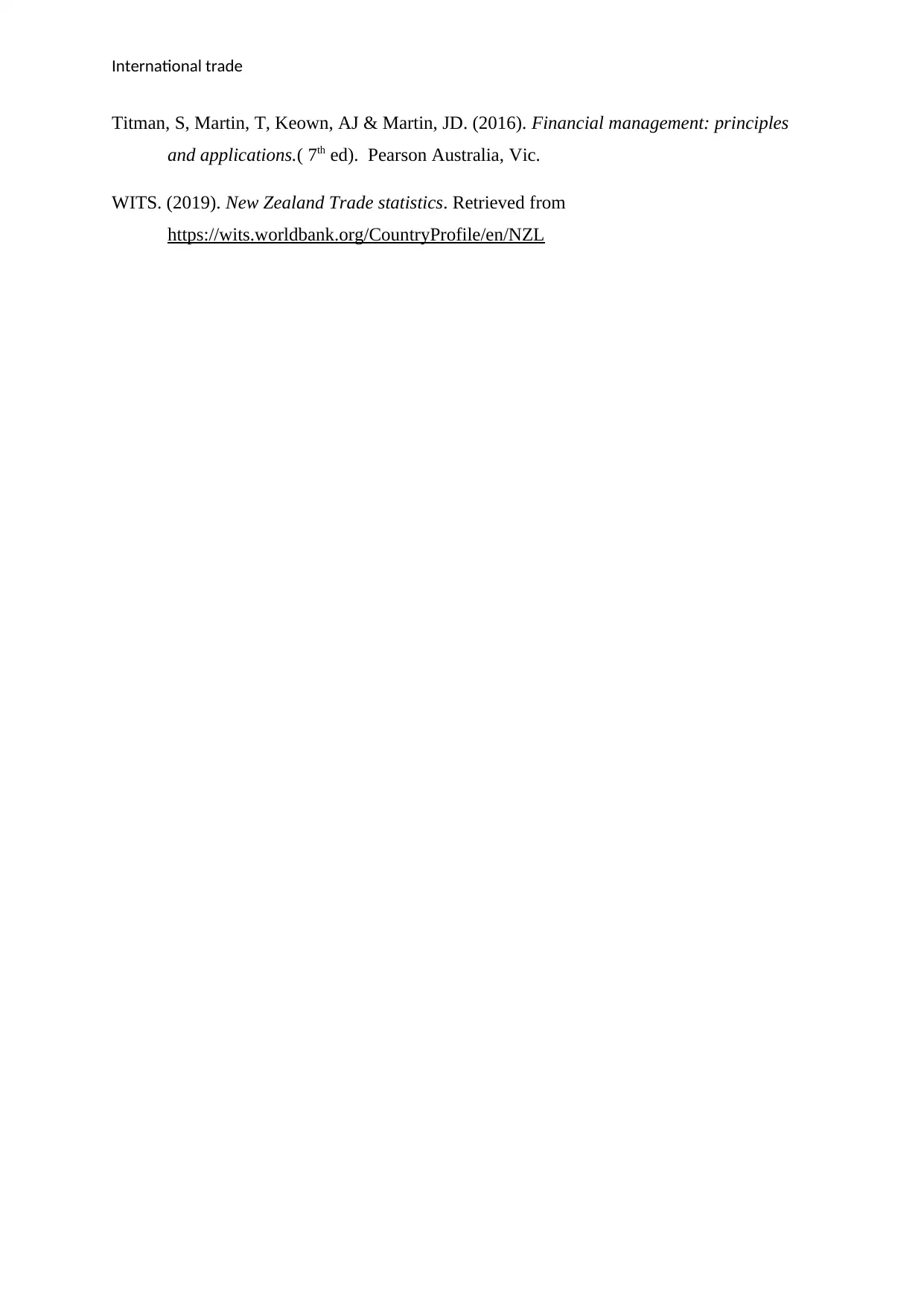
International trade
Titman, S, Martin, T, Keown, AJ & Martin, JD. (2016). Financial management: principles
and applications.( 7th ed). Pearson Australia, Vic.
WITS. (2019). New Zealand Trade statistics. Retrieved from
https://wits.worldbank.org/CountryProfile/en/NZL
Titman, S, Martin, T, Keown, AJ & Martin, JD. (2016). Financial management: principles
and applications.( 7th ed). Pearson Australia, Vic.
WITS. (2019). New Zealand Trade statistics. Retrieved from
https://wits.worldbank.org/CountryProfile/en/NZL
1 out of 15
Related Documents
Your All-in-One AI-Powered Toolkit for Academic Success.
+13062052269
info@desklib.com
Available 24*7 on WhatsApp / Email
![[object Object]](/_next/static/media/star-bottom.7253800d.svg)
Unlock your academic potential
© 2024 | Zucol Services PVT LTD | All rights reserved.





